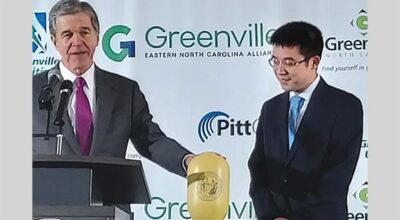They’re back
Published 1:49 am Friday, May 10, 2013
The invasion is imminent.
After laying in wait for 17 years, millions — if not a billion — of 17-year cicadas will invade the eastern United States any day.
Some scientists and residents have reported some cicadas already emerging from the ground, but cicada experts have said the full-blown invasion has not yet started.
In 2011, the invasion by millions of 13-year cicadas occurred. Cicadas have prominent, bright-red eyes. Some folks have dubbed the 2013 invasion by the cicadas as “Swarmageddon.”
While underground, cicadas feed by sucking roots.
Cicadas announced their presence with the loud and surreal din of their mating calls. Other than being rather noisy at times, people often wonder if cicadas pose threats to farmers’ crops and residents’ gardens.
“Many folks who experienced large cicada populations in 2011 were left with damaged young trees and bushes where the female cicadas cut slits into tree branches to lay their eggs. The cicadas prefer stems and branches about the diameter of a pencil to deposit their eggs; on mature trees only the branch tips are damaged and the trees recover but on young trees the damage can occur on the main trunk and on primary lateral branches, causing significant damage. Cicadas only feed on woody perennials, so vegetable and/or strawberry crops are not at risk,” according to Debbie Roos, a N.C. Cooperative Extension Service agent in Chatham County. “I know first-hand the damage these cicadas can do to young trees as I had to replace several newly planted native trees in my pollinator garden in Pittsboro after the Brood XIX emergence in 2011. The damage was all up and down the central leaders and lateral branches and was definitely not confined to branch tips. The stems were all at the perfect, apparently most enticing pencil-sized diameter that cicadas prefer and they did a number on them. If only a few branches are damaged they can be pruned out but when the majority of branches are significantly damaged, the young tree or bush might need to be replaced.”
Entomologists agree that farmers and gardeners with young fruit trees, brambles and blueberries may find them potentially vulnerable to damage caused by cicadas. Hannah Burrack, a small-fruit entomologist at North Carolina State University, said in all likelihood populations of the 17-year Brood II cicadas are not anticipated to be as large as the 13-year Brood XIX cicadas were two years ago.
“Damage to plants from adult cicada feeding is typically minimal, even for large, periodic emergences. Of greater concern is the damage that females cause through egg laying. Adult cicadas lay their eggs in woody tissue, under the bark. From the outside, these oviposition scars look like ragged cuts,” reads a blog by Burrack.
The Christian Science Monitor reports that cicadas pose no serious threat to human life, but may sting a little if they mistake a human for a tree.






